May 19, 2025 | 19:54 GMT +7
May 19, 2025 | 19:54 GMT +7
Hotline: 0913.378.918
May 19, 2025 | 19:54 GMT +7
Hotline: 0913.378.918
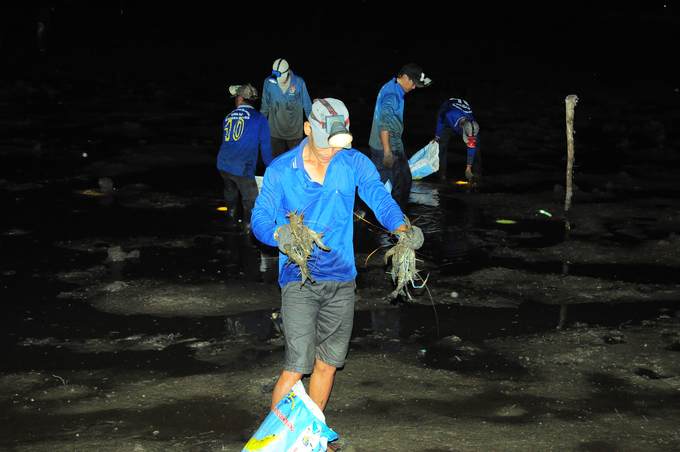
At the break of dawn, the people of Luong Nghia commune, Long My district, Hau Giang province, eagerly harvest blue-legged shrimp. Photo: Kim Anh.
In the past, when discussing rice cultivation in the area along the Cai Ngan Dua River in Luong Nghia commune, Long My district, Hau Giang province, local farmers would often shake their heads in frustration. This region was once considered a "challenging" land, largely due to its location outside the Long My – Vi Thanh dike system. The area faced severe environmental challenges, with saltwater intrusion becoming a frequent problem during the dry season, while the rainy season brought floods that submerged the fields. As a result, farmers could only grow one rice crop per year.
Despite these hardships, a positive change began to emerge. In 2016, with the goal of improving the livelihood of local farmers, the People's Committee of Luong Nghia commune, working in partnership with the Hau Giang Department of Agriculture, introduced a new approach: the rice-shrimp farming model. By 2023, this model had gained significant traction and expanded rapidly, bringing about positive economic results for the local community.
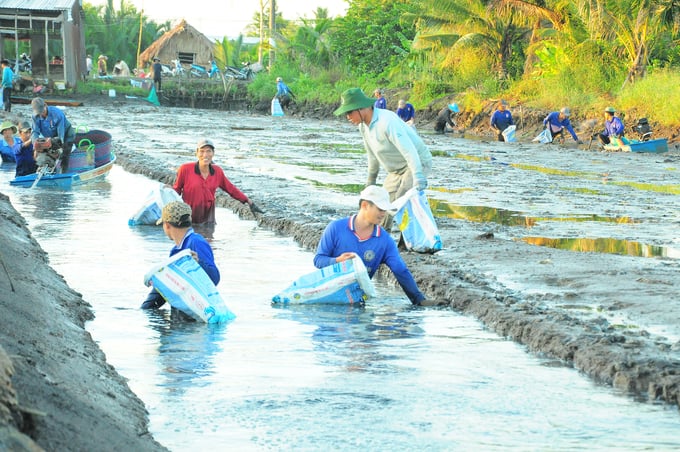
The rice-shrimp farming model was introduced in Luong Nghia commune in 2016 and began to see strong growth in 2023. Photo: Kieu Trang.
When visiting Luong Nghia commune during the shrimp harvest season, one can truly appreciate the growing vitality of the rural area. Starting as early as 4 a.m., dozens of farmers, with headlamps on their heads and bags in hand, carefully comb through every corner of the rice fields and ponds, expertly catching the shiny, lively shrimp that are still bouncing on the surface of the water.
Mr. Nguyen Van Ngoc, the Vice Chairman of the People's Committee of Luong Nghia commune, expressed that the rice-shrimp farming model is proving to be highly effective and bringing positive outcomes. He highlighted that in 2024, shrimp production had reached very good levels. Compared to the traditional practice of growing just one rice crop a year, the income from shrimp farming is several times higher.
One such example is Mr. Vo Van Bao’s family in Hamlet 6, Luong Nghia commune, who started transforming their rice fields into shrimp ponds in 2016, initially cultivating black tiger shrimp. By 2023, they expanded to include blue-legged shrimp as part of an intercropping system.
A distinctive feature of this farming model is that blue-legged shrimp have a relatively long growth cycle, typically lasting about six months. This allows farmers to intercrop them with other types of shrimp, such as black tiger shrimp or white-leg shrimp, creating a mix of short-term and long-term income sources.
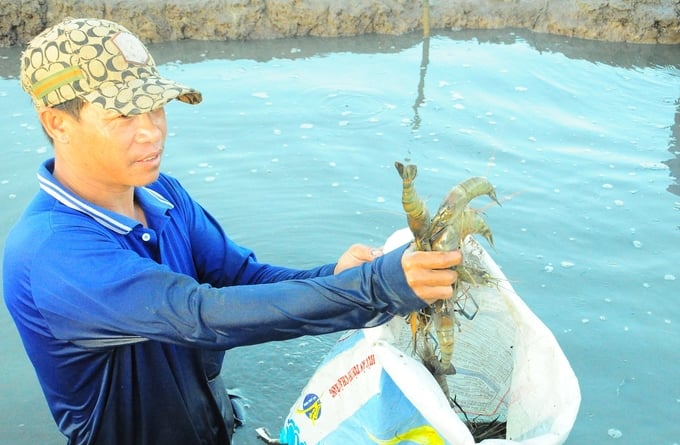
Compared to monoculture rice farming, the rice-shrimp model has significantly increased the income of local farmers. Photo: Kim Anh.
After the Lunar New Year, local farmers take advantage of the salty water to flood their fields, while simultaneously improving the soil in preparation for raising black tiger shrimp and blue-legged shrimp, which will be harvested in about 3 to 3.5 months. About two months later, they restock the ponds with white-leg shrimp, which can be harvested in around 45 days. After harvesting the shrimp, farmers continue to prepare the land and plant their winter-spring rice crop.
Evaluating the effectiveness of this model, Mr. Bao calculated that on 1 hectare of land, he stocks about 30.000 shrimp larvae, with a harvest yield of over 500 kg (shrimp sized at 10-12 shrimp/kg). As a result, the shrimp alone bring his family a profit of around 1.250 to 1.700 USD.
"Compared to growing rice in the winter-spring season, which is often affected by natural disasters, this model of one rice crop and one shrimp crop offers higher profits and requires less labor. The salinity of around 5-6 parts per thousand is ideal for the growth of black tiger shrimp and blue-legged shrimp", Mr. Bao shared.
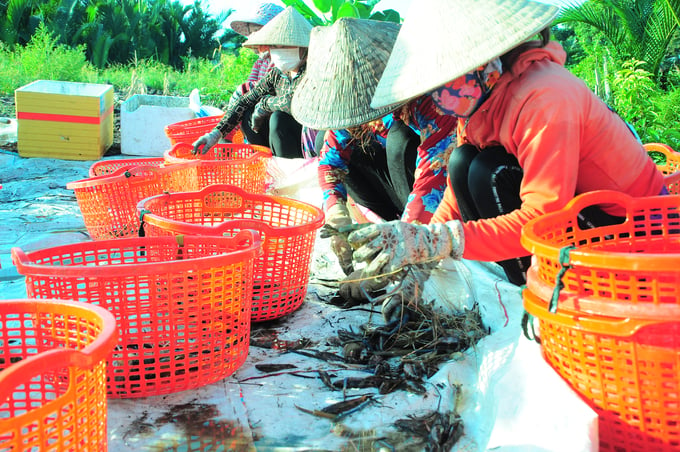
The rice-shrimp farming model has also helped create additional job opportunities for many local women. Photo: Kieu Trang.
In Hamlet 8, Luong Nghia commune, the land was previously covered by forest, and farmers there only cultivated one rice crop per year, which was highly uncertain. However, recognizing the significant economic potential of the rice-shrimp farming model, some members of the Thanh Do Service and Commerce Cooperative decided to diversify their farming practices. They began introducing additional types of aquaculture, such as shrimp and crabs, to complement their rice cultivation, aiming to increase their overall profits on the same unit of land.
Mr. Tran Van Day, the Director of the Thanh Do Cooperative, explained that the cooperative currently consists of 15 members who collectively farm around 200 hectares of rice. Among them, four households have adopted the rice-shrimp-crab intercropping model, covering over 100 hectares in total. This mixed approach, compared to traditional monoculture rice farming, has proven to be more lucrative. On average, the intercropping model generates a profit of more than 626 USD/ha.

Rice-shrimp farming is an economic model that holds great promise in helping farmers increase their income while also protecting the ecological environment. Photo: Kim Anh.
At present, the rice-shrimp farming model has been implemented on approximately 158 hectares in Luong Nghia commune. Looking ahead, the commune's People's Committee plans to further expand this model to areas outside the existing dike system. One of the key focuses will be reclaiming less productive agricultural land to establish new rice-shrimp farming zones, with an estimated additional 100 hectares set to be cultivated under this model.
In addition to these efforts, the Hau Giang Provincial High-Tech Agricultural Zone Management Board is also providing significant support to the local community in developing a 40-hectare rice-shrimp farming area. This initiative includes providing farmers with high-quality seeds, organic fertilizers, and hands-on guidance from agricultural experts on the best practices for rice cultivation and shrimp farming. The long-term goal is to establish a sustainable and organic rice-growing region integrated with shrimp farming.
Translated by Phuong Linh
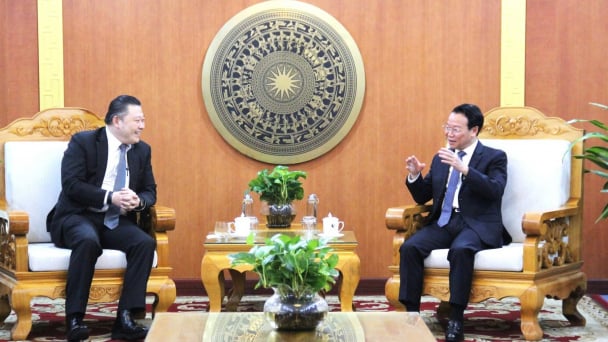
(VAN) Minister of Agriculture and Environment Do Duc Duy held a meeting with Soopakij Chearavanont, Chairman of C.P. Group, on May 15.
/2025/05/16/3800-0-nongnghiep-143756.jpg)
(VAN) Suntory PepsiCo Vietnam coordinated with the Ministry of Education and Training to implement an education program on water conservation, reaching nearly 1 million primary school students nationwide.

(VAN) Vietnam’s TH Group officially put its high-tech fresh milk processing plant into operation in the Russian Federation, marking a historic moment as the first TH true MILK cartons were produced in Russia.

(VAN) Use of high-quality broodstock and biotechnology is regarded as the most effective approach to ensuring sustainable and economically viable shrimp aquaculture ahead of climate change and the emergence of increasingly intricate disease patterns.

(VAN) Carbon farming is a form of agricultural practices that helps absorb more greenhouse gases than it emits, through smart management of soil, crops, and livestock.

(VAN) This is a key content of the Memorandum of Understanding recently signed between the Vietnam Fisheries Society and Kunihiro Inc of Japan.
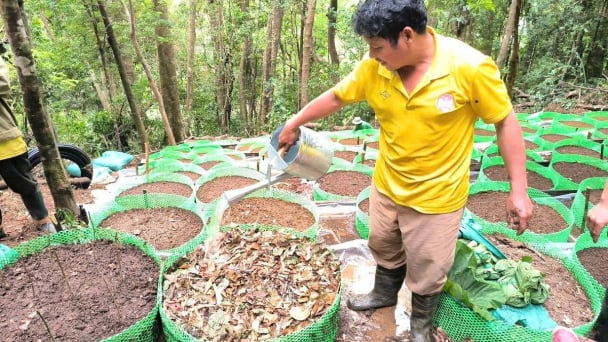
(VAN) To achieve the goal, local authorities and businesses in Kon Tum province have fully prepared the necessary conditions for the new Ngoc Linh ginseng planting season.